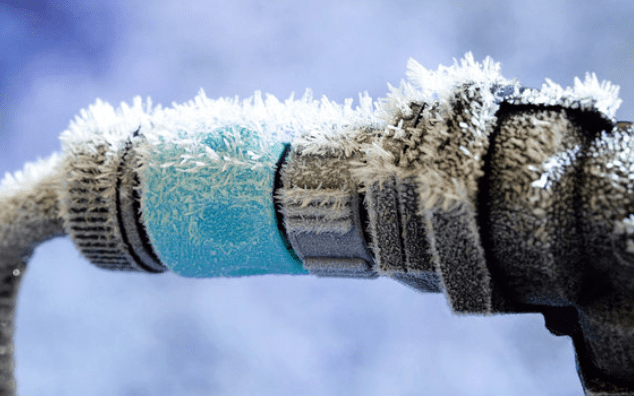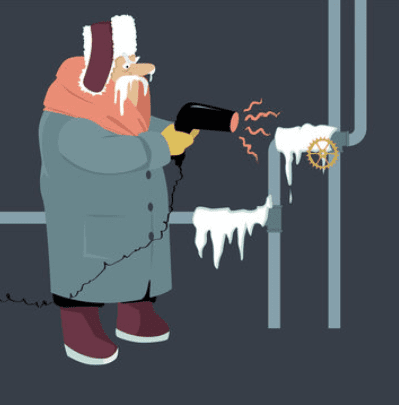
This all-inclusive guide provides reliable and practical advice on how to thaw frozen pipes. Our expert tips can help you prevent substantial water damage and safeguard your property.
Whether you are a homeowner, renter, or property manager, you know winter can spell disaster for your plumbing system. During the colder months, a typical problem households face is freezing pipes.
Let’s dive in and decipher how to tackle this problem.
Understanding the Issue: Why Do Pipes Freeze?
Before we delve into how to thaw frozen pipes, it’s critical to understand why pipes freeze.
Why do Pipes Freeze?
In simple terms, pipes freeze due to plummeting temperatures. But it’s not just any pipe that freezes; those in unheated spaces such as basements, crawl spaces, and garages are more susceptible to freezing. Even pipes running through cabinets or exterior walls can freeze.
The Science Behind Frozen Pipes
When the water inside these pipes freezes, it expands. This expansion exerts pressure on the pipe from the inside, which can lead to its bursting. The actual burst often happens not at the point where the ice blockage exists but between the blockage and the nearest open faucet. The reason? Increased pressure because of the ice blockage.
What Does It Mean For Your Home?
A burst pipe is a plumbing emergency that can cause significant water damage to your property. So, it’s essential to understand the process and figure out how to thaw frozen pipes effectively.
The Signs of Frozen Pipes
The earlier you can detect a frozen pipe, the better. Here are some telltale signs that could suggest you have a frozen pipe in your house.
Unexpected Changes in Water Flow
If you notice a strange trickle or complete stop in water flow during the cold months, this could be because of a frozen pipe.
Visible Frost on the Pipes
The exterior of the pipe may exhibit frost accumulation under certain circumstances. This frost can be an explicit warning sign of a frozen pipe.
Unusual Smells
A strange smell from your drain or faucet might show a pipe is frozen. A blockage in the pipe will force the odor from the drain to come back up into your property.
How to Thaw Frozen Pipes
Now that we’ve established the warning signs, we must review how to thaw frozen pipes.
Locate the Frozen Pipe
The first step in this process is to locate the frozen pipe. Remember that the pipe’s frozen section might not always be visible or accessible.
Open the Faucet
Once you’ve located the frozen pipe, open the faucet it feeds. This will relieve the pressure build-up in the pipe and allow the water to escape once it thaws.
Apply Heat
Apply heat to the section of the pipe that is frozen. We can do this using various methods, such as an electric heating pad, a hairdryer, or a portable space heater.
Remember, safety comes first! Never use an open flame device as it could damage the pipes and potentially lead to a fire.
Preemptive actions: Preventing frozen pipes
Prevention is always better than a cure. So, before we ask how to thaw frozen pipes, let’s discuss some ways to prevent pipes from freezing.
Insulate Your Pipes
Insulation is one of the most effective ways to prevent your pipes from freezing. You can use pipe sleeves, heat tape, or even newspaper to insulate your pipes.
Let Your Faucets Drip
This might seem counterintuitive, but allowing your faucet to drip slightly can prevent the pipe from freezing. The theory is simple – moving water does not freeze.
Keep the Heat On
Even when you’re away from home, keep the heat on. It’s better to pay a little extra on your energy bill than to pay for the significant damage a burst pipe can cause.
FAQs: How to Thaw Frozen Pipes

1. How long does it take to thaw a frozen pipe?
The time to thaw a frozen pipe can vary depending on its size, location, and the method used to thaw it. On average, it can take a few hours to a full day.
2. Can I use a blowtorch to thaw frozen pipes?
It’s strongly advised against using a blowtorch or any open flame device to thaw a frozen pipe. This could cause the water inside the pipe to boil, resulting in a burst, or it could even start a fire. Stick to safe methods such as a hairdryer, heating pad, or warm towel.
3. What do I do if my pipes burst?
If a pipe bursts, immediately shut off the water at the main shutoff valve to prevent further water damage. Then, call a professional plumber to repair or replace the burst pipe.
4. Can I thaw a frozen pipe without water access?
Yes, even if you can’t get water access, you can still use a heat source like a hairdryer or heating pad to thaw the pipe.
5. What temperature causes pipes to freeze?
Typically, the temperature alert threshold for frozen pipes is 20 degrees Fahrenheit.
6. Are some pipes more prone to freezing than others?
Yes, pipes in unheated areas of a house, such as basements, attics, and garages, are more susceptible to freezing. Similarly, pipes running in exterior walls or cabinets are also at a higher risk.
Final Word
Understanding how to thaw frozen pipes is vital to saving you from a potential plumbing disaster. As we’ve seen, it involves knowing what causes pipes to freeze, the telltale signs of a freeze, effective thawing techniques, and proactive prevention measures. When we speak of techniques, we mean safe and effective methods such as heating pads, hairdryers, and space heaters. It’s crucial to refrain from using open flame devices like blowtorches, which are hazardous.
Recognizing the signs of a frozen pipe early can help prevent a small problem from escalating into a major catastrophe. Symptoms like reduced water flow, frost on the pipes, and odd smells can signal that it’s time to spring into action.
In addition to these reactive measures, taking a proactive stance can make a difference. Some preventive measures are insulating your pipes, letting faucets drip, and keeping the heat on, even when away.
It’s essential to know that pipes in unheated areas of your home, such as the basement, attic, and garage, as well as those running through exterior walls and cabinets, are more susceptible to freezing. You should be especially vigilant when the temperature dips below 20 degrees Fahrenheit.
And remember, if a pipe bursts, you must act swiftly to minimize water damage. Shut off the water at the main shutoff valve and call a professional plumber.
Having this knowledge at your fingertips can help you protect your property and, most importantly, provide peace of mind during those chilly winter months. So, the next time the temperature takes a nosedive, you’ll know what to do if your pipes freeze. Stay warm, stay safe, and keep your lines flowing freely.






















